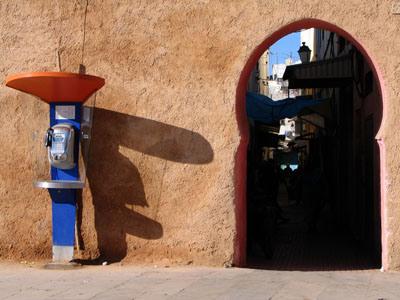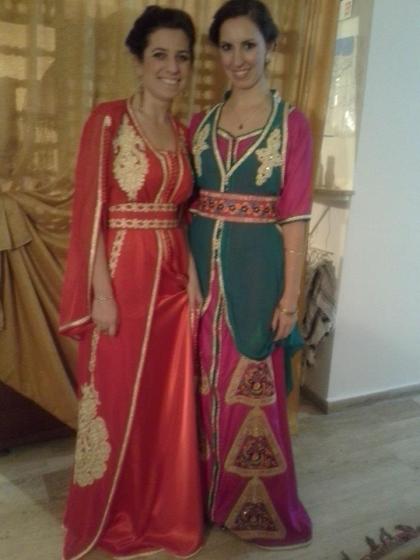“Morocco is…,” is a statement I try to avoid making, because it is cumbersome, stereotypical, and leaves no room for the brilliance of our imagination and the diversity of reality. Frankly, I don’t know what Morocco is at all. There are so many different Morocco’s, as each person lives and experiences this country in a different manner.
I live my life on what the French call “mi-chemin,” which literally translates to “mid path.” I love the idea of always being mi-chemin — on a journey — somewhere in the in between. But I also think that this word can translate to an intersection or the crossing of two paths. In this case, I’m also living at an intersection; one of culture and identity, and more specifically, one of tradition and modernity.
Recently, I’ve begun observing a fascinating juxtaposition between tradition and modernity. The more I think about it, the more aware I am of how these two worlds weave their way through the lives of those who call Morocco home. Tradition versus modernity? Not neccesarily. It’s not completely a versus — not black and white. Rather, it’s more of a mi-chemin. An intersection.
At this point I find myself with the necessity of defining modernity and tradition. This is a feat in itself, and one I do not wish to over simplify. Therefore, instead of defining it, I will give you examples of how I have experienced these these criss-crossing worlds.
1. A donkey on the tram
A friend recently told me he saw a man trying to bring his donkey onto the tram. The tram, which runs two lines across Rabat, is the very essence of modernity for this city. Not only does it look like a silvery gray spaceship, but for a minimal price you can conveniently commute across town. When he told me about what he saw, I laughed because it was simultaneously ridiculous and exactly the kind of thing that would happen here. The donkey, of course, is a symbol of tradition; it’s the very antithesis of rapid, convenient technology. And yet, these two worlds collided mi-chemin as this brilliant man attempted to coax his ass onto the tram. I don’t blame him for trying.
2. Micky D’s and conterfeits
Commercial colonization has penetrated itself into Morocco. That’s to say, those who can afford Western name brands, which include both fast food chains and clothing stores, are gung-ho. McDonald’s, for example, is one of the most adored restaurants in this city. It’s posh and American and oh-so-fantastically modern. It’s always chock-full of customers dressed to the nines. Right down Avenue Mohammed V, where McDonald’s and big stores flamboyantly boast their presence, there’s the medina — the old city. Where a westerner such as myself feels like they’ve stepped backwards in time. It’s bustling and chaotic and noisy and the informal economy reigns supreme. Vendors sell their goods from stalls or in the streets and anything is possible if your patient and willing to haggle. The informal aspect of the economy is what I consider to be the keeper of tradition in the medina and throughout Morocco. Though McDonald’s hasn’t stamped its name in the Medina (yet), many other name brands can be informally purchased there. So friends, place your orders for the newest software and technology, because copyrights do not exist in Morocco. You can purchase the most expensive up-to-date products for a fraction of the cost in the Medina. A true (and amazing) intersection of tradition and modernity.
3. A Moroccan wedding
Last weekend I attended a “traditional” Moroccan wedding. I was a guest of the brother of the groom, and he advised that I wear the traditional costume, a takcheta. All the women would be wearing one, and I would stand out if I wasn’t properly garbed. It was fun, and I felt a bit like my 7 year old self, as I dressed up in my princess gown for the ball. Upon arrival, it was clear that I had made the right decision to wear the takcheta. All the women were decked out. But as I looked around the room, there was one lone man wearing the traditional white jalaba. Every other man was wearing his nicest suit and tie. Again, an intermingling of old and new. The fashion here in Morocco, is very much a melange of these two narratives. You see both men and women wearing traditional Moroccan clothes, as well as those who wear western name brands. They are not mutually exclusive, however, and many people mix it up depending on the day. I, myself, have been on the hunt for a jalaba and I just purchased my very first pair of babouche slippers. I have a feeling they will soon become a staple in my wardrobe.
It doesn’t feel abnormal to me. In fact, I actually think that it’s really cool that Moroccans have found so many ways to retain their heritage while simultaneously transitioning between the stark and contrasting worlds of tradition and modernity.



thanks for the update..i love reading about your adventures…the donkey story was fab…
happy holidays to you..it will be fun to read how you celebrate them…
I was thinking I should take a jackass for a ride on the gondola up on the mountain here in Stowe, but then
there are plenty of them riding it on any given day! I love your blog, and I’m anxious to see you next week. Have a safe journey. ~XO~XO
You look great in the takcheta. What a beautiful traditional gown.
Thank you so much!
cool page loved reading it
Beautiful experience. Thanks for sharing.
Lovely musings on the intersection of tradition and modernity. It is never really black and white and you have captured that poignantly in this post. Thanks and happy journeys.
Morocco has always been a different world. Enjoy for me.
Mi-chemin is an interesting concept, I embrace it wholly.
Love your writing, I will have to see this world in person one day.
Thank you! I highly recommend it! Rabat is CNN’s #2 rated place to visit in 2013!
Now I know never to try an coax my ass onto the tram in Morocco 😉 Lovely rumination here, loved learning the term “mi-chemin” – also the space I believe myself to exist in.
Always happy to teach new things! I’ll check out your blog to see what I can learn from you!! I’m sure you have much to share as well!
So true. The mixing of old and new. I visited Morocco once, briefly. Amazing place. Was in Taiwan and Hong Kong for three years. There’s a crazy mix of old and new there, too, and even more so in China, I’ve heard. The world we live in is a ever evolving… Glad for observant people like you. Congrats on being freshly pressed!
Thank you! What were you doing in Taiwan and Hong Kong?! I’d love to go there!
Morocco is certainly an interesting place and worthy to be on anyone’s bucket list. Thanks for sharing your wonderful experiences. :=)
CNN Rated Rabat the #2 place to visit in 2013!
hi how are you guys
superb writing.
Follow me!
Loved this post, a great reflection on Morocco (a place I am absolutely dying to visit lol!) It’s so funny how elsewhere McDonald’s is seen as upscale but here it’s…definitely not! (In Egypt McDonald’s is considered ‘expensive,’ which just makes me laugh). I like that modernity and tradition can still exist mi-chemin, because then you get the best of both worlds 🙂
I rarely eat at McDonald’s but it’s always an affair when I do! Such great people watching!
Thanks for sharing your wonderful experiences.very nice….
I live near a large Amish community and I see this same clash between the old and the new. A man driving a buggy using a cell phone. Monsanto brand fertilizer being spread on a field with a horse drawn tractor. The farmer who butchers chickens in his backyard but will take a credit card. It’s wonderful. I love living in such a mi-chemin community!
Wow! I often forget that even in the United States we have such distinctions between tradition and modernity. I grew up in the North East, but I’ve had rare exposure to Amish communities. Thank you for your comment! It’s always nice to make connections between my travels and the USA!
A lovely and well-articulated observation of the continuing globalization and modernization of the rest of the world. I love the stories and photos.
Reblogged this on Oyia Brown.
that gown is pretty beautiful and the writing work is even better